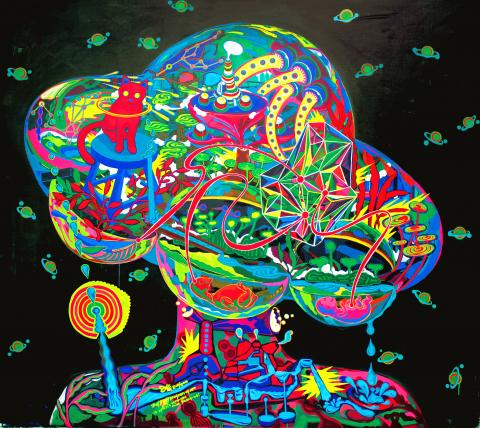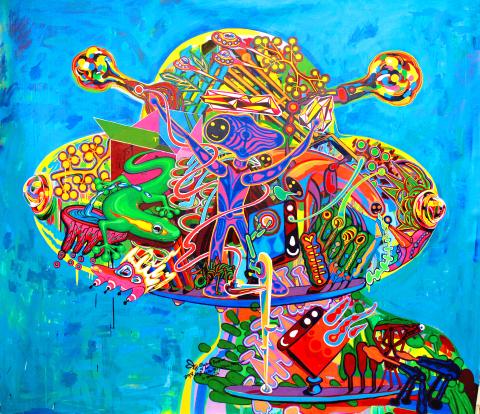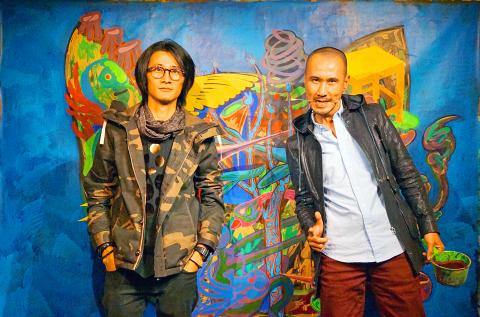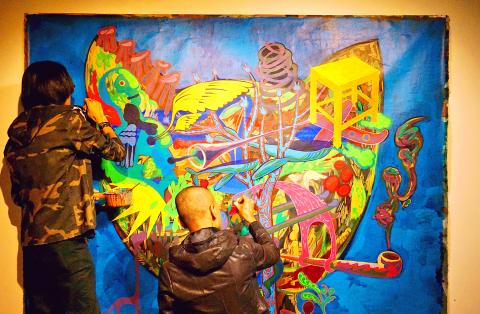Lu Mu-jen (呂沐芢) and Chiao Sheng-wei (焦聖偉) are childhood best friends and artists who are out of this world. Their collection of artwork depicting various alien, plant and animal life forms intertwined inside UFO-shaped single-celled organisms is currently on display at Frees Art Space (福利社) in Taipei’s Zhongshan District (中山).
When asked if they believe in aliens, both artists responded in the positive with blank looks on their faces which read, why is this question even being asked? Lu has never seen an alien in real life, but Chiao says he’s seen something that looked like a UFO when he was at graduate school in Greater Tainan. Despite their different experiences though, both artists steadfastly believe that life on other planets exist and use this as inspiration for their newest collection, the Euglena Program of Art.
COMMUNICATION IS KEY

Photo Courtesy of Association of the Visual Arts in Taiwan
The artists were putting the finishing touches on their latest addition to the collection, dabbing paint on their canvas in near-perfect sync as photographers snapped away and reporters scribbled in their notepads. Lu and Chiao never discuss what to paint beforehand. Their style is impromptu and organic — they simply pick up their brushes and see where the painting takes them.
“It’s like we are having a conversation with each other but with brush strokes, not words, and it’s exciting not knowing what the next brush stroke or what the end result will be” Lu said.
Communication is one of the key messages in their artwork. Within the earth itself there are numerous modes of communication, many of which are not discernible to the human eye or ear.

Photo Courtesy of Association of the Visual Arts in Taiwan
“Take dolphins for instance,” Lu said, referring to the dolphins in many of their paintings. “They are highly intelligent creatures who communicate through their sonar abilities.”
Lu and Chiao’s logic is that just because humans cannot see, hear, touch, taste or feel something does not mean that it does not exist. Naturally, this logic extends to aliens and life on other planets — perhaps other-worldly creatures use other means of communication, and they have been trying to reach out to us, but we simply cannot detect their message.
The Euglena Program of Art is essentially Lu and Chiao projecting this logic onto canvas. As Chiao says, “no one can yet prove the existence of aliens, so we feel like we have to express it through art instead.”

Photo: Dana Ter, Taipei Times
OTHER-WORLDLY BUT DOWN-TO-EARTH
From afar, the Euglena Project of Art resembles colorful UFO heads. Up close, it’s more of a mish-mash of animals, organisms and elements thrown together — dolphins that swim upstream, cats that smoke cigars and aliens that sprout eagle-like wings. And yet — maybe it’s the random smiley faces interspersed throughout almost every painting — it just seems like everything is coexisting in perfect harmony, or at least, the different elements are trying to understand each other.
“We draw such animals and aliens altogether because they are all very smart creatures,” Lu said.

Photo: Dana Ter, Taipei Times
He adds that he and Chiao both grew up loving the abundance of nature in Taiwan and watching all sorts of television shows and movies. As a result, their art has been influenced by four main tenets: aliens, nature, environmental issues and human beings like Bruce Lee (李小龍) or Michael Jackson who have changed the world in a positive way.
“Such a combination is not possible in real life, but in art, it’s possible,” Chiao says, “therefore, our paintings represent a type of hope.”
Just as there is no definitive answer to the question “do aliens exist?”, there is no definitive meaning behind Lu and Chiao’s paintings. Lu says that the paintings show how “aliens are trying to teach us peaceful messages like mutual understanding and how to preserve the environment.”
Chiao says that to him, the most important message is “a feeling of harmony.”
Likewise, each individual will have his or her own interpretation, although Lu and Chiao say that they hope their artwork will evoke happy feelings in their viewers since they were largely inspired by elements and experiences which made them happy.
So, while Lu and Chiao may seem out of this world, their desire for peaceful coexistence amongst the various elements of worldly and other-worldly life forms is rather endearing and down-to-earth.

Oct. 21 to Oct. 27 Sanbanqiao Cemetery (三板橋) was once reserved for prominent Japanese residents of Taipei, including former governor-general Motojiro Akashi, who died in Japan in 1919 but requested to be buried in Taiwan. Akashi may have reconsidered his decision if he had known that by the 1980s, his grave had been overrun by the city’s largest illegal settlement, which contained more than 1,000 households and a bustling market with around 170 stalls. Fans of Taiwan New Cinema would recognize the slum, as it was featured in several of director Wan Jen’s (萬仁) films about Taipei’s disadvantaged, including The Sandwich

“Wish You Luck is not just a culinary experience, it’s a continuation of our cultural tradition,” says James Vuong (王豪豐), owner of the Daan District (大安) Hong Kong diner. On every corner of Kowloon, diners pack shoulder-to-shoulder over strong brews of Hong-Kong-style milk tea, chowing down on French Toast and Cantonese noodles. Hong Kong’s ubiquitous diner-style teahouses, known as chachaanteng (茶餐廳), have been a cultural staple of the city since the 1950s. “They play an essential role in the daily lives of Hongkongers,” says Vuong. Wish You Luck (祝您行運) offers that same vibrant melting pot of culture and cuisine. In

Much noise has been made lately on X (Twitter), where posters both famed and not have contended that Taiwan is stupid for eliminating nuclear power, which, the comments imply, is necessary to provide the nation with power in the event of a blockade. This widely circulated claim, typically made by nuclear power proponents, is rank nonsense. In 2021, Ian Easton, an expert on Taiwan’s defenses and the plans of the People’s Liberation Army (PLA) to break them, discussed the targeting of nuclear power plants in wartime (“Ian Easton On Taiwan: Are Taiwan’s nuclear plants safe from Beijing?”, April 12, 2021). The

Artificial intelligence could help reduce some of the most contentious culture war divisions through a mediation process, researchers say. Experts say a system that can create group statements that reflect majority and minority views is able to help people find common ground. Chris Summerfield, a co-author of the research from the University of Oxford, who worked at Google DeepMind at the time the study was conducted, said the AI tool could have multiple purposes. “What I would like to see it used for is to give political leaders ... a better sense of what people ... really think,” he said, noting surveys gave